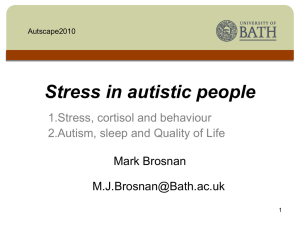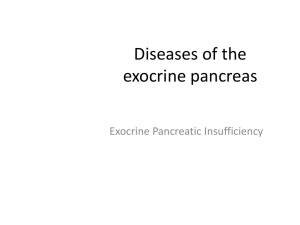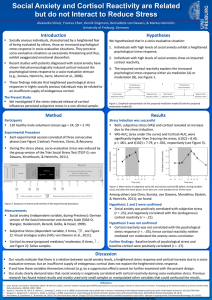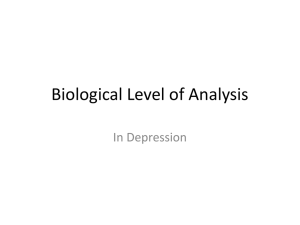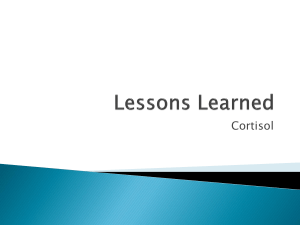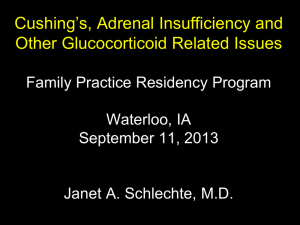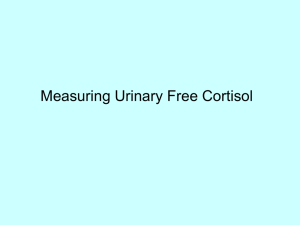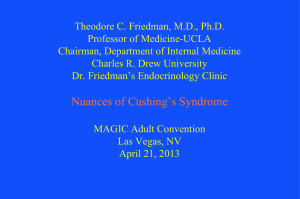20120315PasireotideForCushing (2839574bytes)
advertisement
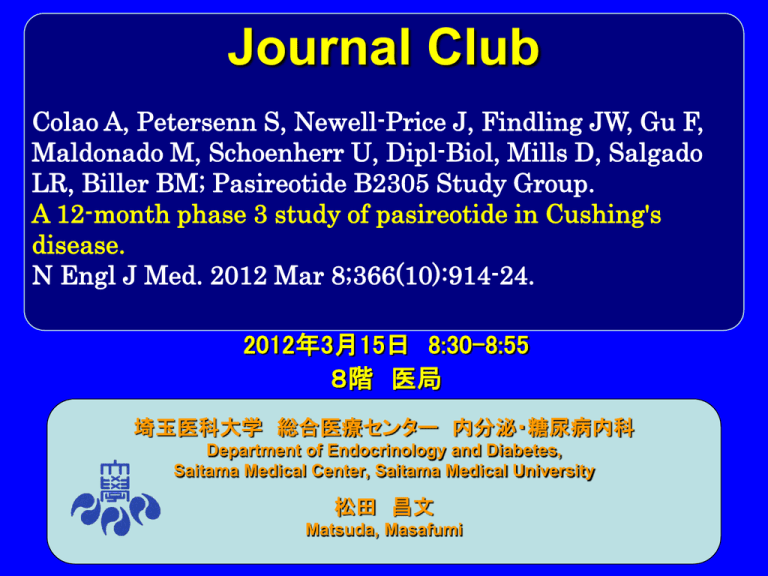
Journal Club Colao A, Petersenn S, Newell-Price J, Findling JW, Gu F, Maldonado M, Schoenherr U, Dipl-Biol, Mills D, Salgado LR, Biller BM; Pasireotide B2305 Study Group. A 12-month phase 3 study of pasireotide in Cushing's disease. N Engl J Med. 2012 Mar 8;366(10):914-24. 2012年3月15日 8:30-8:55 8階 医局 埼玉医科大学 総合医療センター 内分泌・糖尿病内科 Department of Endocrinology and Diabetes, Saitama Medical Center, Saitama Medical University 松田 昌文 Matsuda, Masafumi 1.消化管ホルモン産生腫瘍 通常、成人にはオクトレオチドとして20mgを4週毎に3ヵ 月間、殿部筋肉内に注射する。その後 は症状により10mg、 20mg又は30mgを4週毎に投与する。ただし、初回投与後2 週間は薬物濃度が十分な濃度に達しな いことから、本剤投 与前に投与していた同一用量のオクトレオチド酢酸塩注射 液を併用する。 2.消化管神経内分泌腫瘍 通常、成人にはオクトレオチドとして30mgを4週毎に、殿 部筋肉内に注射する。なお、患者の状態 により適宜減量す ること。 3.先端巨大症・下垂体性巨人症 通常、成人にはオクトレオチドとして20mgを4週毎に3ヵ 月間、殿部筋肉内に注射する。その 後は病態に応じて10mg、 20mg又は30mgを4週毎に投与するが、30mg投与で効果が不 十分な場合に限り40mgまで増 量できる。 ソマトスタチンは、血中半減期が2~3分と短いため臨床上での応用 ができませんでした。 そこで、ソマトスタチンの生物学的活性を示すのに重要な部分である 4つのアミノ酸(Phe-Trp-Lys-Thr)をそのままの配列で残し、 disulfide(S-S)結合をはさんでD-PheとThr(ol)を配した8個のアミノ 酸よりなる環状ペプチドとしたものがオクトレオチドです。これによっ て作用の持続性が得られ、ソマトスタチンに比べ成長ホルモン(GH) に対する選択性が高く、強力な作用を持つことが可能になりました。 サンドスタチンLARは、長期にわたるオクトレオチド酢酸塩による治 療を可能とするために開発された徐放性製剤です。従来の1日2~3 回の皮下注射を、4週毎に1回の筋肉内注射とすることで、1ヵ月あた りの注射回数を約1/60~1/90と著しく減らすことができることから、投 与の利便性・コンプライアンス及び治療受容の向上が期待できます。 サンドスタチン注射液50μg 経路:注射薬|規格:50μg1mL1管 ||薬価:1930.00 サンドスタチン注射液100μg 経路:注射薬|規格:100μg1mL1管 |薬価:3449.00 サンドスタチンLAR筋注用10mg 経路:注射薬|規格:10mg1瓶(溶解液付) |薬価:121201.00 サンドスタチンLAR筋注用20mg 経路:注射薬|規格:20mg1瓶(溶解液付) |薬価:216706.00 サンドスタチンLAR筋注用30mg 経路:注射薬|規格:30mg1瓶(溶解液付) |薬価:304843.00 J Clin Endocrinol Metab, June 2010, 95(6):2781–2789 Percentage change in pituitary tumor volume from baseline (before octreotide treatment) to the end of the study after 3 months of pasireotide treatment in the 51 assessable patients. The 14 de novo patients, all of whom had a macroadenoma, are highlighted in gray. 用法/用量 メチラポンとして1回500~750mgを1日6回4時間毎に経口投与する。 小児には、1回15mg/kgに相当する量を1日6回4時間毎に経口投与するが、1回の最小 量は、メチラポンとして250mgが望ましい。 the Department of Molecular and Clinical Endocrinology and Oncology, Section of Endocrinology, University of Naples Federico II, Naples, Italy (A.C.); ENDOC Center for Endocrine Tumors, Hamburg, and the Faculty of Medicine, University of Duisburg–Essen, Essen — both in Germany (S.P.); the Department of Human Metabolism, University of Sheffield, Sheffield, United Kingdom ( J.N.-P.); the Division of Endocrinology, Metabolism, and Clinical Nutrition, Medical College of Wisconsin, Milwaukee ( J.W.F.); the Department of Endocrinology, Key Laboratory of Endocrinology, Ministry of Health Peking Union Medical College Hospital, Beijing (F.G.); Clinical Development, Oncology Business Unit, Novartis Pharma, Basel, Switzerland (M.M., U.S., D.M.); the Division of General Internal Medicine, Hospital das Clínicas, University of S.o Paulo Medical School, S.o Paulo (L.R.S.); and the Neuroendocrine Clinical Center, Massachusetts General Hospital, Boston (B.M.K.B.). N Engl J Med 2012;366:914-24. BACKGROUND Cushing’s disease is associated with high morbidity and mortality. Pasireotide, a potential therapy, has a unique, broad somatostatin-receptor–binding profile, with high binding affinity for somatostatin-receptor subtype 5. a 40-fold increased affinity to somatostatin receptor 5 METHODS In this double-blind, phase 3 study, we randomly assigned 162 adults with Cushing’s disease and a urinary free cortisol level of at least 1.5 times the upper limit of the normal range to receive subcutaneous pasireotide at a dose of 600 μg (82 patients) or 900 μg (80 patients) twice daily. Patients with urinary free cortisol not exceeding 2 times the upper limit of the normal range and not exceeding the baseline level at month 3 continued to receive their randomly assigned dose; all others received an additional 300 μg twice daily. The primary end point was a urinary free cortisol level at or below the upper limit of the normal range at month 6 without an increased dose. Open-label treatment continued through month 12. washout periods for patients on medical treatment Inhibitors of steroidogenesis (ketoconazole, metyrapone): 1 week Dopamine agonists (bromocriptine, cabergoline): 4 weeks Rosiglitazone: 1 week Octreotide LAR and Lanreotide Autogel: 8 weeks Lanreotide SR: 4 weeks Octreotide (immediate release formulation): 1 week Figure 2. Mean Change in Urinary Free Cortisol Levels from Baseline to Month 12 and Proportion of Patients with Normalized Levels at Month 6. Panel A shows the mean urinary free cortisol level at time points up to month 12 according to dose group; the change from baseline to months 6 and 12 was significant for both the 600-μg group (P<0.001) and the 900-μg group (P<0.001). The dashed line represents the upper limit of the normal range (ULN), which is 145 nmol per 24 hours. The mean percentage change in the urinary free cortisol level from baseline to month 6 was –27.5% (95% CI, –55.9 to 0.9) in the 600-μg group and –48.4% (95% CI, –56.6 to –40.2) in the 900-μg group; the corresponding changes from baseline to month 12 were –41.3% (95% CI, – 66.0 to –16.6) and –54.5% (95% CI, –65.2 to – 43.7). The median percentage change in the urinary free cortisol level was –47.9% (95% CI, – 74.1 to –40.7) in the 600-μg group and –47.9% (95% CI, –66.9 to –35.5) in the 900-μg group at month 6 and –67.6% (95% CI, –72.7 to –42.4) and –62.4% (95% CI, –78.7 to –38.5), respectively, at month 12. I bars indicate standard errors. Panel B shows the percentage of patients in whom the urinary free cortisol level was at or below the ULN at month 6, categorized according to whether hypercortisolism at baseline was mild (urinary free cortisol level, >1.5 to 2 times the ULN), moderate (>2 to 5 times the ULN), or severe or very severe (>5 times the ULN). Items included in the CushingQoL questionnaire. 1. I have trouble sleeping (I wake up during the night; it takes me a long time to get to sleep, etc.) 2. I have pain that keeps me from leading a normal life 3. My wounds take a long time to heal 4. I bruise easily 5. I am more irritable, I have sudden mood swings and angry outbursts 6. I have less self-confidence, I feel more insecure 7. I’m worried about the changes in my physical appearance due to my illness 8. I feel less like going out or seeing relatives or friends 9. I have had to give up my social or leisure activities due to my illness 10. My illness affects my everyday activities such as working or studying 11. It’s difficult for me to remember things 12. I’m worried about my health in the future The instructions read: the following sentences refer to what you may think or feel about your Cushing’s syndrome. Your answers will help us to know how you feel and how much your illness has interfered in your usual activities in the past 4 weeks. Below each sentence you will find several response choices. Please read each sentence carefully. After reading each sentence, check the box next to the answer that best describes what you think is happening to you. There are no rights or wrong answers. We are simply interested in what is happening to you because of your Cushing’s syndrome. Eur J Endocrinol 2008;158:623-30. Figure 3 (previous slide). Changes in Signs and Symptoms of Cushing’s Disease and Urinary Free Cortisol (UFC) Levels over Time in the Overall Study Population. Panel A shows systolic blood pressure, Panel B diastolic blood pressure, Panel C triglycerides, Panel D low-density lipoprotein (LDL) cholesterol, Panel E body weight, and Panel F health-related quality-of-life (HRQoL) score. HRQoL was measured with the use of the CushingQoL questionnaire (in which scores range from 0 to 100, with higher scores indicating better quality of life). The numbers of patients included in analyses of mean UFC levels at various time points were as follows: 153 at baseline, 144 at 1 month, 132 at 2 months, 131 at 3 months, 123 at 4 months, 116 at 5 months, 111 at 6 months, 93 at 9 months, and 77 at 12 months. The corresponding numbers of patients included in analyses of the mean values for signs, symptoms, and quality-of-life scores are shown beneath each graph. I bars indicate standard errors for both UFC level and clinical signs and symptoms. To convert the values for triglycerides to mg per deciliter, divide by 0.01129. To convert the values for LDL cholesterol to mg per deciliter, divide by 0.02586. RESULTS Twelve of the 82 patients in the 600-μg group and 21 of the 80 patients in the 900-μg group met the primary end point. The median urinary free cortisol level decreased by approximately 50% by month 2 and remained stable in both groups. A normal urinary free cortisol level was achieved more frequently in patients with baseline levels not exceeding 5 times the upper limit of the normal range than in patients with higher baseline levels. Serum and salivary cortisol and plasma corticotropin levels decreased, and clinical signs and symptoms of Cushing’s disease diminished. Pasireotide was associated with hyperglycemiarelated adverse events in 118 of 162 patients; other adverse events were similar to those associated with other somatostatin analogues. Despite declines in cortisol levels, blood glucose and glycated hemoglobin levels increased soon after treatment initiation and then stabilized; treatment with a glucose- lowering medication was initiated in 74 of 162 patients. CONCLUSIONS The significant decrease in cortisol levels in patients with Cushing’s disease who received pasireotide supports its potential use as a targeted treatment for corticotropin secreting pituitary adenomas. (Funded by Novartis Pharma; ClinicalTrials.gov number, NCT00434148.) Message 尿中遊離コルチゾール値が正常上限値の1.5倍 以上あるクッシング病の成人患者162人を対象 に、ソマトスタチンアナログpasireotideの効 果を二重盲検第3相試験で検証。600μg投与群、 900μg投与群(各群とも2回/日)の両群で2カ 月目までに尿中遊離コルチゾールの中央値が約 50%と有意に減少し、その後も安定した。 で、LAR製剤とかも出るかもしれないが、お値 段は?...

